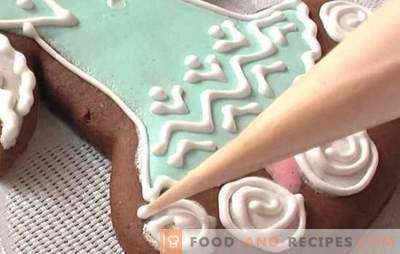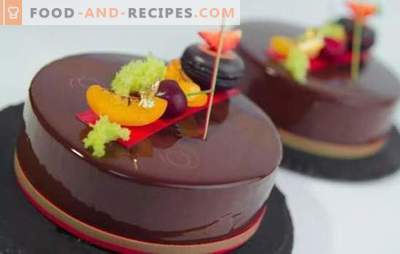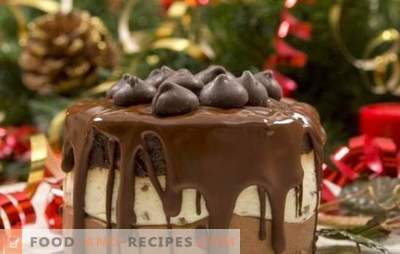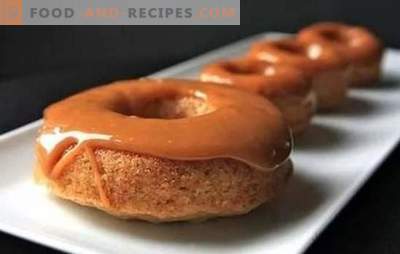
Kulichs are not available without icing. She gives a festive look and completes the preparation of festive pastries. Unfortunately, coverage does not always meet expectations. Sometimes it does not dry or stick, flakes or crumble when sliced. What is the best way to cover the cakes?
Classic protein glaze
Our mothers and grandmothers prepared exactly this kind of icing. Now there is a lot of controversy about it. Someone does not like that it is showered. Some people are against using raw eggs. However, this is a classic version, which is still popular.
Ingredients
- 200 g of sugar or powder;
- 1 protein;
- 1 tsp. lemon juice.
Method of preparation
- In a dry and clean bowl, beat the protein.
- Continuing to beat, add the icing sugar in it. You can just use sand, but it dissolves longer.
- Add lemon juice at the end. Can be replaced with diluted citric acid in water.
Vanillin can be added to this glaze, which will kill the smell of eggs or other essences. At will it is allowed to paint in any shades with gel dyes.
Common Errors
- Adding sugar before proteins are whipped. As a result, the icing remains liquid for a long time, and then dries poorly. Sand or powder should be injected into the fluffy protein mass in small portions.
- Lack of lemon juice. It is needed not only for taste, but also affects the hardening of the glaze, makes the mass stronger.
- Application on a cold surface. The drying process may be delayed. On hot and warm Easter cakes glaze seizes much faster.
Sugar icing from powder with milk
This version of the glaze will suit even novice cooks or help out in the absence of a mixer. You do not need to whip, the main thing is to have finely ground powdered sugar. You can buy it or cook it yourself on a coffee grinder, and then sift. Milk take any fresh, fat does not matter.
Ingredients
- 100 g of powdered sugar;
- 2-3 spoons of milk.
Method of preparation
Heat milk to hot. Pour the powder in a bowl, add milk in droplets, carefully rub. No need to rush to inject milk, powder will soon begin to melt. Once the icing reaches a fluid state, it is ready!
By the way, very often raw protein is used instead of milk. It is lightly whipped with a fork and powder is added until the desired consistency is obtained. If a raw egg does not scare, then you can use this option.
Common Errors
- Low in milk. If the icing is thick, then it will quickly dry out, there will be difficulties when applying.
- A lot of milk. The powder will continue to melt, the icing will become even thinner.
- Long-term storage. Sugar icing with milk dries quickly, so you need to use immediately or put in an airtight container.
- Drawing on a warm and hot cake. Unlike protein glaze, this kind of fudge is best used on a cooled surface.
Plastic glaze with gelatin
We can say that this is the perfect glaze for Easter cakes. It turns out amazing white color, does not contain raw eggs, glitters, perfectly freezes. But the main advantage over other recipes is plasticity, the icing does not crumble when cutting, it does not climb from the cake.
Ingredients
- 160 g of sugar;
- 1 tsp. gelatin;
- 6 spoons of water.
Method of preparation
- We start with gelatin. Add to it two spoons of water. Leave to swell. By time we focus on the instructions. If instant gelatin is used, then a few minutes is enough.
- Pour the remaining four spoons of water into a saucepan, add sugar and boil syrup. Willingness is determined by the soft ball. We drip syrup into cold water, if it thickens, you can roll a ball, then it's ready.
- Remove the pan with the syrup from the stove, leave for five minutes, then add the swollen gelatin, stir until dissolved.
- Immerse the mixer and whip the gelatin syrup. Very soon it will turn into air and white mass. The more it cools, the thicker it becomes. We use as intended.
By the way, in a similar way you can make chocolate icing, you only need to add a spoonful of high-quality cocoa powder when whipping.
Common Errors
- The icing has cooled too much. This can not be done, the mass instantly freezes.
- Prepared for future use. This version of the glaze should be used immediately, as soon as whipped, the remains can not be determined anywhere.
- Gelatin with lumps. To prevent them from appearing, dilute the powder should be water at room temperature.
- Unpleasant smell. It often appears from gelatin, can be disguised with any essence or vanilla.
- The icing flows. Most likely, it has not cooled to the required temperature yet, it is necessary to beat the mixer well again and cool it. The second possible reason is poor quality gelatin, or added to boiling syrup.
Chocolate Icing: Yes or No
There is a lot of controversy over the use of chocolate icing on Easter cakes. Theoretically, it is suitable for decorating a festive muffin, has a pleasant taste, can be made from white chocolate. In practice, it is very crumbling, it does not fit well on a smooth surface.
The way out is to make plastic chocolate icing like ganache. To do this, when melting the tiles add fat cream or butter in an amount up to 35% of the total weight.
The main mistakes in the preparation of chocolate glaze
- Using low quality tiles, porous chocolate, or with fillings.
- Coating warm or hot cakes. Chocolate icing is used only on a cold surface.
- Add a large amount of butter, cream to the glaze.
Secrets of the perfect cover for the cake
- Powders should be applied to the glaze immediately, so that they stick to the sticky surface. This especially applies to fast-setting options, for example, to glaze on gelatin.
- If the icing turned out to be thick, then it will not work out nicely and smoothly. It is better to slightly dilute the mass with a few drops of water, sugar syrup, milk.
- If the icing flows, does not keep on the cake, then you need to add some more powdered sugar in it.
- Liquid glaze can be conveniently applied with a silicone brush, any number of layers can be applied.
- If the icing is thick, then you can put it on the cake with a silicone spatula or just with your hand. Smears should be made large, rare, straight, it is impossible to crawl in one place with curls.























